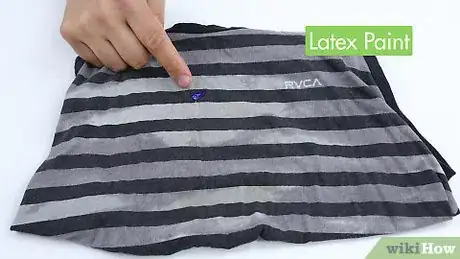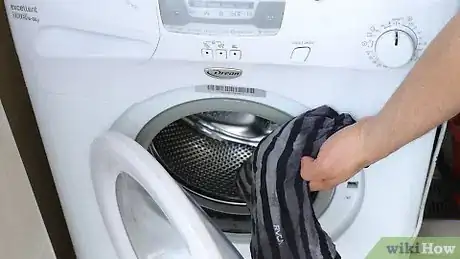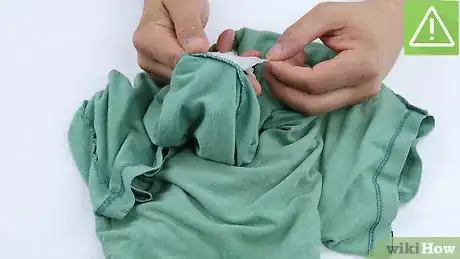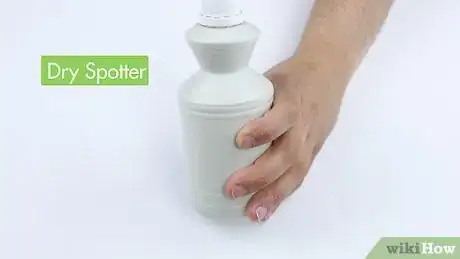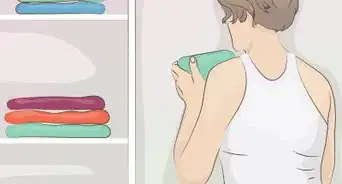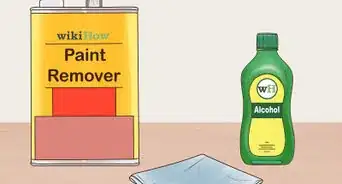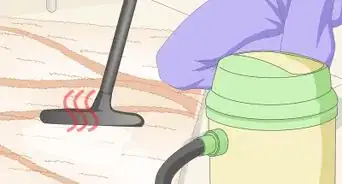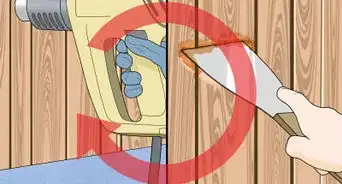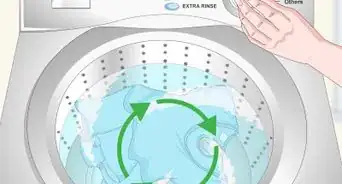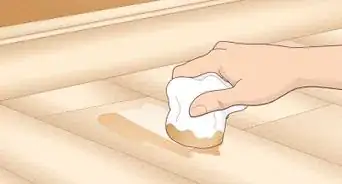This article was co-authored by Susan Stocker. Susan Stocker runs and owns Susan’s Green Cleaning, the #1 Green Cleaning Company in Seattle. She is well known in the region for outstanding customer service protocols — winning the 2017 Better Business Torch Award for Ethics & Integrity —and her energetic support of green cleaning practices.
wikiHow marks an article as reader-approved once it receives enough positive feedback. In this case, several readers have written to tell us that this article was helpful to them, earning it our reader-approved status.
This article has been viewed 1,212,667 times.
We’ve all been there. An innocent craft project leads to splotches of paint on your favorite shirt or pair of jeans (you were so careful too!). The good news is that paint stains can usually be removed from clothing, and there are a few different tricks you can try. The best method for removing paint from clothes actually depends on the type of paint it is. You’ll also want to be extra careful when removing paint from delicate fabrics so you don’t damage them. Don't worry—we've got you covered with all of the details below.
Steps
Removing Latex Paint Stains
-
1Identify latex paint stains. Latex paint is the most common paint used in modern interiors, and is a popular choice for low-cost craft paint. It is also known as acrylic or acrylic latex paint.
- Check the can or tube of paint for the words "latex" or "acrylic latex." If you see this label, follow the steps below to remove your stain.
- If the paint can is unavailable, think back through your past painting projects. Did you clean your brushes with water or paint thinner? If you used water, you were most likely working with latex paint, and can use the steps below.
-
2Remove excess paint from clothing. As soon as the spill happens, scrape off as much paint as possible using a butter knife, the edge of a spoon, or a similar object. The more time the paint has to dry, the less likely you are to remove it.
- If the paint has already dried or you are tackling an old stain, scrape off as much as possible before you attempt to clean it with water or another liquid agent.
- If your clothing has many layers of dried paint, you can use tape to remove many of them. Apply a strong tape like heavy duty duct tape, gaffer’s tape or auto repair tape to the surface of the stain, then quickly remove the tape. It should bring the dried paint with it!
- Be sure to dispose of excess paint responsibly, following the disposal process listed on the paint can.
EXPERT TIPSusan Stocker runs and owns Susan’s Green Cleaning, the #1 Green Cleaning Company in Seattle. She is well known in the region for outstanding customer service protocols — winning the 2017 Better Business Torch Award for Ethics & Integrity —and her energetic support of green cleaning practices.Cleaning Guru
 Susan Stocker
Susan Stocker
Cleaning GuruOur Expert Agrees: If the paint is still wet, put dishwashing liquid on the paint, then scrub and rinse in cold water. If the paint's dried, scrape off as much as you can with a metal spoon, then blot the remaining paint with a dry white cloth and rubbing alcohol.
Advertisement -
3Rinse the stain with warm running water. Latex paint is a mixture of water and acrylic, so there is a good chance you can remove fresh paint with water. Begin rinsing from the back of the fabric. Rub or scrape at the paint as you rinse to loosen its hold and to help the water get through the stain.
-
4Apply a cleansing solution to the stain. Using an emulsifier will help break up and remove the paint stain. You can use a purchased cleanser like Goof Off, or you can use a homemade solution.
- A mixture of hand soap and dish washing detergent makes a great paint cleanser, especially for fresh stains. Combine the hand soap and detergent in a small bowl, using a 1 to 1 ration. Apply the solution to the paint stain using a sponge, and tamp it repeatedly for at least 1 minute. Then rinse in warm water and repeat as necessary until the stain is gone or nearly gone.
- If you are working with a dried stain, use hairspray or isopropyl alcohol to remove the paint. [1] Rub the hairspray or alcohol onto the stain for one minute, then rinse using warm water. Repeat this step as necessary until the stain has disappeared or seriously faded.
-
5Launder your clothing normally. After you have rinsed the last of your chosen cleansing agent from your clothing, launder it according to the item’s care instructions. The wash cycle should remove any remaining paint, but be sure to check that the stain is fully removed before you dry your clothing. Drying a remaining stain will only make it more difficult to remove.
Removing Oil Paint Stains
-
1Identify oil paint stains. Though oil paint was once a popular choice for all types of projects, it is now primarily used for art and specialty crafts. Oil paint tends to be thicker and glossier than latex paint, and takes considerably longer to dry.
- If you are unsure if you are dealing with an oil paint stain, check the can or tube of paint for the words "oil paint" or "oil-based paint."
- If the paint can or tube is unavailable, try to remember how you cleaned your brushes or other materials after painting. Did you use water, or was a paint thinner such as turpentine required? If you used turpentine, white spirit or another, similar product, you were most likely using oil paint and can follow the steps below.
-
2Remove as much of the paint as possible. If the paint is still wet, scrape excess paint away with a knife or the edge of a spoon, then blot the stain with a white cloth. If the paint has dried, scrub it with a knife or a strong-bristled brush.
- Do not apply water or rinse the stain. This will only make the stain more difficult to remove.
-
3Decide what oil paint solvent or thinner to use. To remove an oil paint stain you will need to use a chemical paint solvent. There are many products available, and your stain may require a particular cleaner.
- Check the paint can for a recommended cleaner.
- If you are working with specialty craft paint, check an art supply store for a specialized cleaner.[2]
- If you cannot find a recommendation for a specific cleaner or if you do not have time to find and purchase a recommended solvent, you can use turpentine or white spirits on most oil-based stains. Distilled turpentine can be purchased at any home improvement or paint store.
- However, you should never use turpentine on fabrics containing acetate, triacetate or rayon, so be sure to check your garment’s care information before proceeding.
-
4Apply the oil paint solvent to the article of clothing. Turn the stained clothing inside out and place it on top of a white absorbent cloth or a stack of paper towels. Using another white cloth or paper towel, sponge or blot your paint solvent over the stained area until the stain disappears.
- Replace the cloth or towels under the clothing as they become wet. This will help ensure that the cloths will continue absorbing the paint as it dissolves.
- Watch your fabric for color bleeding or running. If you notice that the colors in your clothing are beginning to run, stop applying solvent. It is unlikely that you will be able to remove the paint stain from this item.
-
5Soak the item of clothing in warm water. Leave the garment to soak for at least an hour, preferably longer. Occasionally rub the stained area with your hands to loosen the remaining solvent.
- Rub a high-quality laundry detergent into the stained area before soaking.
- If you don’t have laundry detergent, mix dishwashing soap into the warm water to help cut the grease in the paint and solvent.
-
6Launder the garment immediately after soaking. Remove your clothing from the warm water, give the stained area one last scrub, and then wash it according to its care directions.
Removing Paint From Sensitive Fabrics
-
1Identify sensitive or dry-clean only clothing. If you are unsure about whether or not your clothing item is dry-clean only, check the care information and fabric content on its tag. Fabrics that are commonly dry-clean only include acetate, silk, wool, and velvet. Even if your clothing does not include these materials, if the care tag says "Dry Clean Only" follow the steps below to remove any latex or oil paint stains.[3]
-
2Remove excess paint using a butter knife or a spoon. It is best to treat paint stains when they are still wet, so be sure to remove as much paint as possible as soon as you notice the stain.
- It is possible to damage sensitive fabrics by scrubbing too hard or using harsh brushes. For this reason it is best to remove excess paint using the dull side of a spoon or another similarly dull object.
-
3Blot the stain with a dry cleaning solution. Using a sponge dampened with a dry cleaning solution like Afta, gently blot the stain. To keep the stain from spreading, begin blotting from the outside edge of the stain and work your way to the center.
-
4Next, blot the stain with a dry spotter. Dry spotters contain dry solvents that will absorb grease and oil stains, and they are particularly helpful when removing oil paint stains.
- You can purchase dry spotter, or you can make it at home using coconut oil and liquid dry cleaning solvent.[4]
-
5After blotting the stain with dry spotter, moisten a cloth with dry spotter and lay it on top of the stain. This will help pull the paint stain out of the clothing. Keep a cloth and dry blotter on the stain until it disappears.
- To prevent the stain from running or bleeding, change the cloth often.
- Keep the stain and the clean cloth damp with the dry spotter. They won't remove the paint when dry, and allowing the stain to dry will make it harder to remove later.
-
6Rinse with dry cleaning solvent. Once the stain has been completely removed, rinse the area one more time with dry cleaning solvent. This will help remove the dry blotter and any remaining oil or grease. Then let your clothing dry normally.
Community Q&A
-
QuestionHow do I do it if the paint is dry?
 Community AnswerYou can use rubbing alcohol or hairspray as it says above. That helps, and vinegar and baking soda might do the trick.
Community AnswerYou can use rubbing alcohol or hairspray as it says above. That helps, and vinegar and baking soda might do the trick. -
QuestionHow do I remove white paint off a black shirt?
 Community AnswerPut vinegar on the paint stain, and let it soak. Rinse the vinegar off, and then put the shirt in the laundry to wash as you normally would.
Community AnswerPut vinegar on the paint stain, and let it soak. Rinse the vinegar off, and then put the shirt in the laundry to wash as you normally would. -
QuestionCan I remove paint from clothes with nail polish remover?
 Community AnswerAcetone, while being extremely good at getting rid of certain types of stains, can actually dissolve certain plastics and certain synthetic fabrics. Only it use on fabrics you are absolutely sure that acetone will not damage, but generally, not a good choice.
Community AnswerAcetone, while being extremely good at getting rid of certain types of stains, can actually dissolve certain plastics and certain synthetic fabrics. Only it use on fabrics you are absolutely sure that acetone will not damage, but generally, not a good choice.
Things You'll Need
- Butter knife or similar, dull object
- Emulsifier (Goof Off or homemade solution)
- Laundry soap
- Oil-paint solvent or turpentine
- Dry cleaning solution
- Dry spotter
References
- ↑ http://www.apartmenttherapy.com/diy-mishaps-removing-latex-pai-156925
- ↑ http://www.howtocleanstuff.net/how-to-remove-oil-based-paint-stains/
- ↑ http://www.realsimple.com/home-organizing/cleaning/laundry/do-i-have-to-dry-clean-this
- ↑ http://www.howtocleanstuff.net/how-to-remove-oil-based-paint-from-silk/
- Videos provided by essortment
About This Article
Whether you're removing latex or oil paint, first use a knife to scrape off as much as you can. Then, for latex paint, rub the paint as you rinse your clothes in warm running water to get as much off as possible. You can then use a cleaner like Goof Off or one you make with hand soap and dish detergent to remove the rest of the stain. If you have an oil paint stain, use a chemical paint solvent to remove it completely before soaking your clothes in warm water and then washing as usual. If you want to learn more, like if you want to learn how to get paint off of delicate fabrics, keep reading the article!
